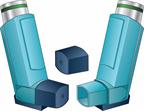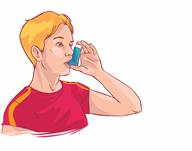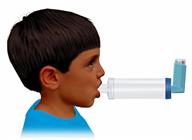How to Use a Metered Dose Inhaler

A metered dose inhaler (MDI) is a handheld device for taking medicine that must be breathed into the lungs (inhaled). The medicine comes in a canister that delivers a spray (puff) of medicine. Each canister holds a certain number of doses.
A spacer (holding chamber) may be used to get more medicine into your lungs.
What are the risks?
-
If the medicine in the MDI is a steroid, it can cause mouth sores. To prevent this, rinse your mouth after you use the MDI. Gargle and spit out the water. Do not swallow the water.
-
If you do not use the MDI in the right way, the medicine may not reach your lungs.
-
The medicine in the MDI may cause side effects. Read the package insert for the medicine to learn more. Ask your health care provider or pharmacist if you have questions.
-
If you do not have enough strength to push down the canister to make it spray, ask your provider for ways to help.
How to use an MDI without a spacer

-
Remove the cap from the MDI.
- If you are using the MDI for the first time, prepare (prime) it for use.
Read the instructions for your inhaler or ask your provider about the number of puffs needed to prime your MDI.
To prime your inhaler, shake it for 5 seconds, turn it away from your face, then send puffs into the air.
-
Shake the MDI for 5 seconds.
-
Position the inhaler so the top of the canister faces up.
-
Put your pointer finger on the top of the canister. Support the bottom of the MDI with your thumb.
-
Breathe out normally and as fully as you can, away from the MDI.
-
Either place the MDI between your teeth and close your lips tightly around the mouthpiece or hold it 1–2 inches (2.5–5 cm) away from your open mouth. Keep your tongue down out of the way. If you are unsure which technique to use, ask your provider.
-
Press the canister down with your finger to release the medicine. Inhale deeply and slowly through your mouth until your lungs are filled. Do not breathe in through your nose. Inhaling should take 4–6 seconds.
-
Hold the medicine in your lungs for 5–10 seconds. This helps it get into the small airways of your lungs.
-
Remove the inhaler from your mouth. Turn your head and breathe out normally.
-
Wait about 1 minute between puffs. Repeat steps 3–10 until you have taken the number of puffs that your provider told you to.
-
Put the cap on the MDI.
How to use an MDI with a spacer

-
Remove the cap from the MDI.
- If you are using the MDI for the first time, prime it for use.
Read the instructions for your inhaler or ask your provider about the number of puffs needed to prime your MDI.
To prime your inhaler, shake it for 5 seconds, turn it away from your face, then send puffs into the air.
-
Shake the MDI for 5 seconds.
-
Put the open end of the spacer onto the mouthpiece.
-
Position the inhaler so the top of the canister faces up and the spacer mouthpiece faces you.
-
Put your pointer finger on the top of the canister. Support the bottom of the MDI and the spacer with your thumb.
-
Breathe out normally and as fully as you can, away from the spacer.
-
Place the spacer between your teeth. Close your lips tightly around it. Keep your tongue down out of the way.
-
Press the canister down with your finger to release the medicine. Inhale deeply and slowly through your mouth until your lungs are filled. Do not breathe in through your nose.
-
Hold the medicine in your lungs for 5–10 seconds. This helps it get into the small airways of your lungs.
-
Remove the spacer from your mouth. Turn your head, and breathe out normally.
-
Wait about 1 minute between puffs. Repeat steps 3–11 until you have taken the number of puffs that your provider told you to.
-
Remove the spacer from the inhaler. Put the cap on the MDI.
Follow these instructions at home:
Caring for your MDI
- Refill your MDI with medicine before all the preset doses have been used.
If your inhaler has a counter, check it to see how full your MDI is. The number you see tells you how many doses are left.
If your inhaler does not have a counter, ask your provider when you will need to refill it. Write the refill date on a calendar or on your MDI canister.
Keep in mind that you cannot tell when the medicine in an inhaler is empty by shaking it. You may feel or hear something in the canister even when the medicine has been used up.
-
Store your MDI in a cool, dry place at room temperature.
-
Follow instructions on the package insert for care and cleaning of your MDI and spacer.
General instructions
-
Take your inhaled medicine only as told by your provider. Do not use the MDI more than you are told to.
-
Do not use any products that contain nicotine or tobacco. These products include cigarettes, chewing tobacco, and vaping devices, such as e-cigarettes. If you need help quitting, ask your provider.
-
Centers for Disease Control and Prevention (CDC):
cdc.gov
-
Contact a health care provider if:
-
Your symptom do not get better with the MDI.
-
You have side effects from the medicine.
-
You are not sure how to use the MDI or your inhaler.
-
Your inhaler is not working like it should.
-
You have a cough that will not go away.
-
You have a very sore mouth or throat and have trouble swallowing.
-
You have severe shortness of breath or trouble breathing.
-
You have chest tightness or chest pain.
-
You have an allergic reaction. Symptoms may include an itchy rash, swelling of the face or tongue, or trouble breathing.
These symptoms may be an emergency. Get help right away. Call 911.
This information is not intended to replace advice given to you by your health care provider. Make sure you discuss any questions you have with your health care provider.


